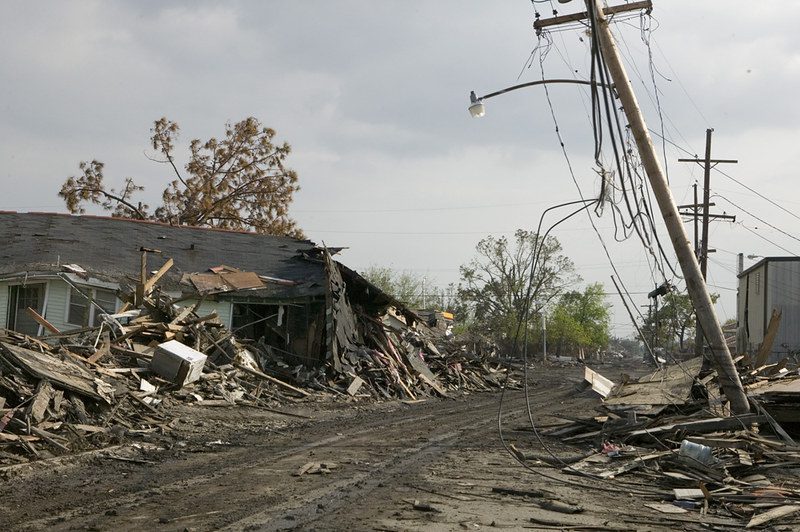
Damaged buildings and debris from Hurricane Katrina line a mud-covered street in the Lower 9th Ward of New Orleans in September of 2005. Photo by Flickr user mad mags, CC BY-NC 2.0
As the 10th anniversary of Hurricane Katrina approached in 2015, I wrote for Shelterforce about flaws in the Louisiana Road Home program and efforts to bring additional resources to the thousands of families who still had not been able to return home. Many of them have been left behind by a grant formula that capped rebuilding awards at the pre-storm value of their homes. This was classic systemic discrimination, baking years of redlining and disinvestment in Black neighborhoods into the very structure of the program.
It has been a tortuous road since then.
Initially there was progress when the U.S. Department of Housing and Urban Development approved revisions to the program that incorporated a new approach to duplication of benefits. If rebuilding funds were spent for interim housing, or taken by mortgage companies or fraudulent contractors, a homeowner could receive additional funds. Unfortunately, the policies had changed but the basic dynamics of how the Road Home program was administered had not. Once again, fear of fraud overwhelmed the purpose of the program. When homeowners presented evidence that they did, in fact, pay rent while their home was unlivable or lose money to a dishonest contractor, it had to meet a standard of proof of beyond a reasonable doubt. The homeowners’ statements, even if made under penalty of perjury, weren’t treated as evidence at all unless they were verified by independent documentation. These requirements fell hardest on those without bank accounts to track their expenditures and those renting from mom and pop landlords who don’t keep electronic ledgers of payments—usually the very people who, because of systemic racism, didn’t receive enough money to rebuild in the first place.
Even so, the Lower 9th Ward Homeownership Association secured $3 million for 34 families to return home. Darrial Sharp, who I wrote about, was finally able to bring his brother Clarence back to the place where he had lived his entire life. One elderly woman only completed her rebuilding last month—more than 16 years after a wall of water obliterated her home. Another 88 families in the New Orleans area were also able to get home, using about $5 million in total federal funds. But there were hundreds more who could have been helped but weren’t. Instead, the Road Home program left $33 million sitting in the bank.
The result of this failure is playing out now. Grant contracts—presented in a time of desperation when hurricane survivors were still traumatized and had no choice but to sign the paper put before them to receive help—included a clause that if the homeowner was unable to rebuild, they would have to repay their award. The Louisiana Office of Community Development is now enforcing this provision, suing those who haven’t made it back home.
The final irony is that a program that began with the purpose of eradicating blight is ending by creating it. Road Home was designed to avoid “devastated communities . . . blighted by abandoned homes, clouded land titles, and disinvestments.” Now, it is taking judgments and putting liens of up to $150,000 in these very neighborhoods. It is causing clouded land titles and disinvestment and it is devastating communities where our missing residents are still mourned.
|
While this piece is free to read, it’s not free to produce. Please consider supporting our small and dedicated team on Patreon. |




Comments